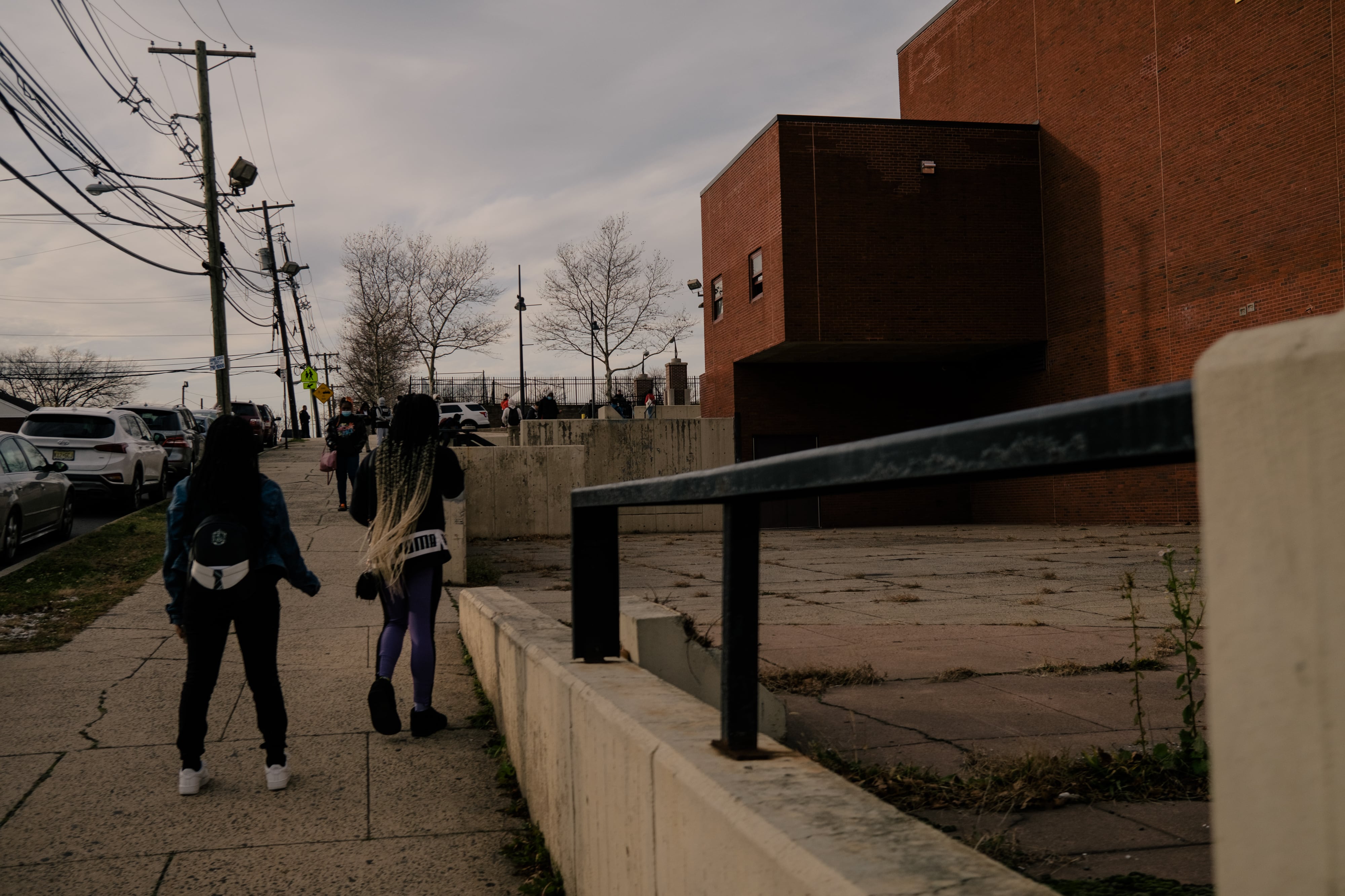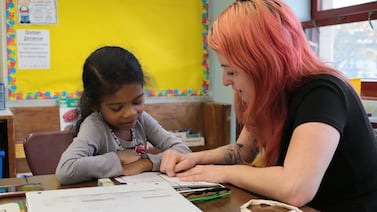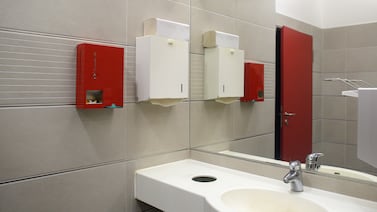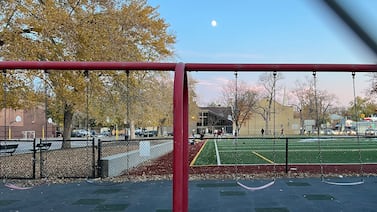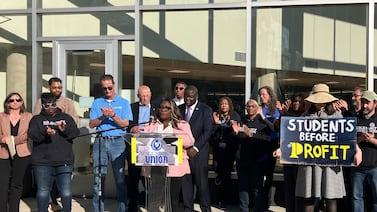The item tucked in a Newark Board of Education committee report was brief, just a few sentences that could have far-reaching implications for the district’s 35,000 students: Replace an outdated security camera system with a “next-generation surveillance platform.”
The new system would include more than 7,000 cameras districtwide — roughly one for every five students — equipped with artificial intelligence to recognize people and objects such as cars and guns, sensors to detect chemicals in vape pens, and remote access to live feeds for authorized staff.
The plan, to be funded in part by federal COVID relief dollars, drew little response at the school board’s monthly business meeting in March. The proposed system would vastly expand the district’s surveillance capabilities, going beyond traditional systems currently used in most districts.
Community advocates and security experts are raising alarms, saying such a system could violate student and staff privacy, lead to overpolicing of students, and not actually protect campuses.
Giovanna Castaneda, a youth organizer at Make The Road NJ, says keeping students safe means more than hiring security guards, installing metal detectors, or buying security cameras. She fears these tools could also be a way of “fueling the system of policing” in schools.
“Cameras can easily just be another way of watching students and punishing them,” Castaneda said.
The push to keep students safe has grown in the wake of a rise in school shootings year after year and high-profile tragedies, like those in Uvalde, Texas and Nashville, Tennessee. While many school districts across the country have ramped up security, new surveillance technologies that are far more complex than traditional cameras are emerging in districts like Newark, experts say.
Artificial intelligence cameras with facial recognition systems, cloud-based systems to manage and store information, and student social media monitoring software are among the tools that experts are seeing districts choose.
But some of these new technologies often come with little to no state or local oversight, critics warn. Without that scrutiny, they say, these tools could be misused, not as effective, or put student privacy at risk.
In Newark Public Schools, that committee summary report said the new camera system is needed because the district’s current security set-up is “outdated, inefficient,” pointing to no remote access, storage, and other limitations.
The report, written by the district’s office of information technology, spells out features officials are looking for: live feeds, higher-quality images, the ability to be programmed to record at certain times of the day, and the potential to track school buses.
Additionally, the system should work with security cameras and sensors to react to the sounds of a gun, glass breaking, and human screaming.
Although the district says it has not started its process to solicit a vendor for the new camera system, the goal is to “enhance security” and the plan is to receive bids before the start of next school year, according to acting communications director Nancy Deering. Officials plan to complete the installation by the end of 2023, Deering said.
In 2021, the district allocated $2.4 million in federal COVID money for security cameras, but Deering said it will not have a final budget for this security overhaul until it chooses a vendor. Officials plan to pick the “most suitable and most cost-effective solution,” Deering added.
But the lack of a firm plan and budget, experts warn, could leave the district vulnerable to aggressive marketing strategies that describe complex security tools and technology as an essential part of keeping students safe at a time when school shootings are a top concern for educators.
“I’ve done a lot of work on stories about school districts because they are one of the largest markets for security products in the United States,” said Conor Healy, director of government research at IPVM, a security and surveillance research group. “Schools tend to make very poor decisions when it comes to the security technology they buy.”
In 2020, the Baldwin County School District in Alabama spent $1 million on thermal cameras that the Food and Drug Administration later said were not authorized under the federal government, according to an IPVM and a CBS affiliate investigation. Similarly in 2022, the Daily Beast reported that more than 200 school districts nationwide purchased thermal scanners and cameras promoted as a way to detect fevers, but which would regularly fail.
Districts bolster security in the name of student safety
Newark is one of many districts nationwide seeking to boost security in the wake of mass shootings. New York City purchased door-locking systems to control who has access to school buildings. Districts like Chicago spent $73.3 million to add and upgrade security cameras and in Memphis, the district is slated to spend up to $6.3 million to bolster security.
And Newark Public Schools has already been increasing security for several years. The school district installed metal detectors to scan students for contraband and weapons and added six new patrol cars for school safety officers. It also provided its security guards with training including on bag scanners, active shooter response, and the drug and alcohol policy. Newark plans to hire more security guards and update its software to track school incidents.
At the state level, Gov. Phil Murphy approved multiple efforts to keep children in schools safe, including $6.5 million in federal COVID relief funds to have school districts digitize school building maps and make them available to first responders in emergency situations. The maps will include aerial views of school buildings, floor plans, and utility shut-offs among other information.
Murphy also approved legislation in August 2022 to require boards of education in each school district to develop and adopt a policy to establish a threat assessment team tasked with identifying students who might be a threat to school safety.
Newark’s plan to overhaul its camera system would be a more ambitious step to monitor students, staff, and those visiting schools.
John Abeigon, president of the Newark Teachers Union, says he is comfortable with adding thousands of cameras in district schools as long as they are kept out of classrooms and teacher’s lounges. In the past, he’s received complaints about cameras being inoperable at specific schools or during certain parts of the day, a problem when students or staff claim that they were injured in hallways or staircases.
“As long as they can maintain a service agreement and keep them operable, we have no issue with them,” Abeigon said.
Privacy and policing concerns grow as new technologies are implemented
While surveillance and security companies sell new tools by promising to promote safety and giving administrators a greater ability to monitor students, experts say officials should carefully weigh the sales pitch against student needs.
Companies such as Verkada and Rhombus market security tools that will “help manage school security” and “create safer schools.” These companies market artificial intelligence capabilities in their surveillance systems that can send real-time alerts to law enforcement agencies and track faces in school buildings.
Similar to facial recognition on phones, security cameras that use artificial intelligence can monitor and keep a log of faces. But these cameras could potentially misidentify items or students and monitor them in ways that could infringe on their privacy, said Dillon Riesman, a Skadden fellow at the ACLU-NJ who specializes in advocacy for civil rights and technology.
Security experts also warn that facial recognition features might not work as well on darker skin tones, posing an extra challenge for students of color who risk being misidentified. That could present a particular concern in a district such as Newark, where nearly 90% of students identify as Hispanic or Black, say policy experts at the American Civil Liberties Union New Jersey.
“These new technologies cost schools millions of dollars for systems and functionality and tools that the school might not need,” Riesman added, “or worse, might actively harm students.”
According to Deering, the Newark Public Schools spokesperson, artificial intelligence offers capabilities that the outdated camera system is not capable of, and says the district’s goal in acquiring these capabilities “is to enhance security, not penalize students.”
Experts also warn of privacy concerns due to hacking, since information is stored in cloud-like platforms. Verkada, for example, uses a cloud-based management system and has had its cameras hacked. Several workers were also accused of accessing the company’s facial recognition system to take and post photos of women at the company, according to CBS News and VICE. In response to the reporting, Verkada fired three employees who abused the company’s monitoring system and updated its systems following the hacking incident.
Verkada declined to comment on their previous hacking incident and employee misuse of facial recognition.
The company has also been accused of dubious marketing practices. It sold technology to public schools throughout North Jersey by recruiting a Bergen County superintendent to help connect the companies’ sales representatives to school employees, who would be offered incentives in exchange for sales meetings, according to VICE.
No legislative oversight over security cameras in schools
Under New Jersey law, school officials can install cameras to keep watch of areas “that could be monitored or patrolled by a person.” There are no strict rules on where they can be placed, but cameras are generally not allowed in bathrooms or locker rooms.
State law also says the best practice is for schools to provide notice of surveillance areas by placing signs near security cameras but it’s unclear if the practice is enforced.
In Newark, which has 3,000 classrooms across the district, Deering said officials cannot disclose where cameras will be placed for security purposes, but they are installed outside school buildings or near entrances.
The state provides districts with funding for school security projects and upgrades, but few guidelines on how to use the funds, according to ACLU-NJ.
During the 2020-2021 regular state legislative session, a bill to include security cameras in certain special education classrooms was introduced but ultimately died. During the 2022-2023 regular session, state Sen. Nia Gill introduced a bill to restrict the use of facial recognition technology and other “biometric recognition” by governmental entities but it failed to move forward.
Senate Majority Leader M. Teresa Ruiz and Senate education committee chair Vin Gopal did not comment on school surveillance technology regulations.
Joe Johnson, policy counsel at the ACLU-NJ, says the lack of state oversight over security and surveillance companies is a problem.
“It is left up to the school districts and sometimes that’s beneficial,” Johnson said. “But other times, students that live in one part of the state have a different experience, whether better or worse, than other students across the state.”
Advocates stress the importance of community engagement
As districts invest taxpayer dollars into these tools and systems, advocates say it’s important to include the community in discussions. In addition, bringing awareness about the implementation of new surveillance technologies could promote trust and better understanding for parents.
District spokesperson Deering said notice about Newark Public Schools’ plan to replace its outdated camera system would be provided to the community “at the appropriate time.”
Dave Maass, director of investigations at the Electronic Frontier Foundation, said community oversight on how these technologies are implemented is important for school communities. Johnson, the policy counsel at ACLU-NJ, said school districts should work on getting “the information in front of parents and students” before new tools are implemented.
“Those conversations lead to a stronger school district because the local community can weigh in on what it is that the students need,” Johnson said.
Castaneda, the youth organizer, believes there needs to be a larger conversation on how funds are used to promote safe school environments. Those dollars could be better spent to tackle the causes that lead to students carrying guns, drugs, or engaging in violence, she said.
“It’s about getting to know the student and knowing where they come from, what they ate, what their family life is like, and getting at the root of the issue,” Castaneda added.
Jessie Gomez is a reporter for Chalkbeat Newark, covering public education in the city. Contact Jessie at jgomez@chalkbeat.org.

